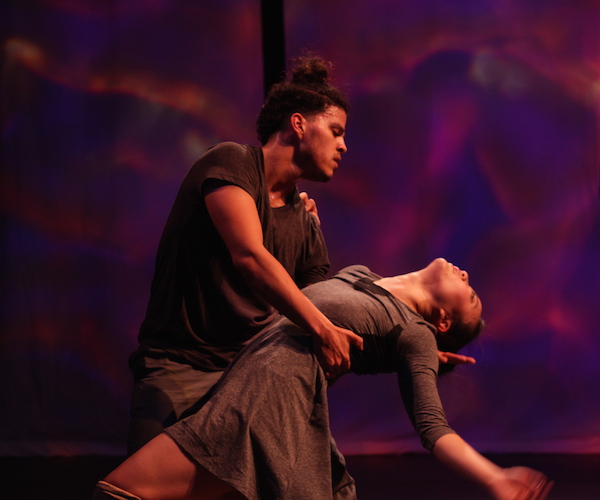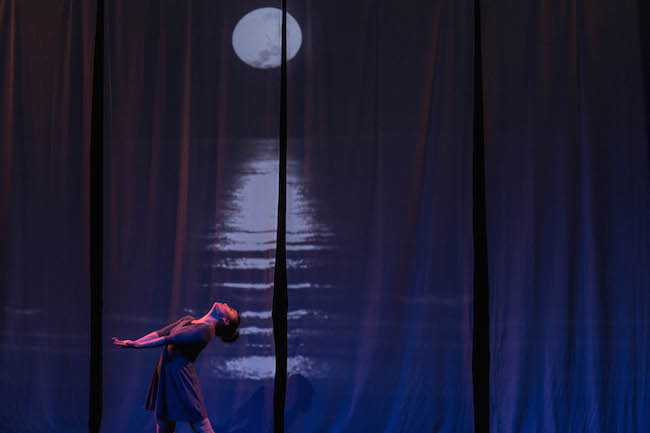Dance Review: The Dream Project II — “Luna Soul,” Eastern Narrative Meets Western dance
Trained in both Eastern and Western dance styles, Artistic Director Chun-Jou Tsai aims to bridge these two cultures through The Dream Project’s syncretic productions.

A scene from The Dream Project’s “Luna Soul.” Photo: August Rose.
By Merli V. Guerra
The Dream Project is the brainchild of its Artistic Director, local dancer and choreographer Chun-Jou Tsai, who originally hails from Taiwan. Trained in both Eastern and Western dance styles, Tsai aims to bridge these two cultures through The Dream Project’s syncretic productions. Two weeks ago, the group launched its second performance to date — Luna Soul, presented at the Multicultural Arts Center in Cambridge — and it was nothing short of mesmerizing.
According to Tsai, Luna Soul derived its inspiration from the story of the renowned Chinese beauty and heroine Xi Shi. The presentation centered on the argument that women have consistently been regarded as “less valuable” than men in traditional Chinese culture. “Xi Shi was seen merely as a pawn,” notes Tsai in the program, “and yet without her there would have been no victory.”
The production featured six works that — though individually delineated — transitioned easily from one to the next. Each provided a variation on the theme of how society dominates the individual.
Throughout the five works choreographed by Tsai, audience members were treated to a contemporary dance style that was powerful yet strikingly fluid. The key to Tsai’s choreography is its intricacy, whether it is expressed through individual, partnered, or group ensemble work. Even without referring to the program notes, one can sit back and reflect on the enticing imagery, shapes, and interconnections unfolding on stage.
The evening was divided into six sections: “Innocence,” “Shaping,” “Pawn,” “Collision,” “Searching,” and “Rebirth.” In the first, the dancers appeared uninhibited, moving freely, commanding the space through twisting motions and sharp inhales. But the second piece suggested how society’s barriers took on physical and visual forms.”Shaping” proved to be one of the production’s most compelling performances: performers Jess Chang and Alex Davis resembled worker bees laying down rows of gray gaff tape on the floor. “Shaping”‘s five performers spiraled across the stage, each quickly became ensnared in his or her own tape square. Tsai’s choice to have Chang and Davis actively working amongst the dancers while remaining emotionally removed (avoiding eye contact, focusing on the job at hand) was a wise one. Their presence added a dimension of imposed conformity — a reminder that a government often lays down its laws without fully learning the needs or wants of its people.
The fourth work of the evening — and the only one that didn’t involve Tsai as a performer or creator — was choreographed by fellow Taiwanese dancer Hsia-Hua Liang. Though noticeably different in style from the other pieces, Liang’s work was a riveting quartet featuring Chang, Jorge Delgado, Kara Foote, and Alison McHorney. As the music accumulated momentum, the dancers generated an equally strong flurry of emotions. “Collision” offered a tumultuous climax that made good use of the athletic agility of the group’s performers.

A scene from The Dream Project’s “Luna Soul.” Photo: August Rose.
The most moving work of the evening came when Tsai alone took the stage in “Searching.” Channeling the calm that follows the storm, “Searching” gave us Tsai fluidly and intricately searching “for her true self”; it was filled with full-bodied twists, glides, and plummets. Quiet, yet potent, the work was set against the video projections of moonlight on water, which transitioned to visuals that reflected Tsai’s introspective thoughts. The solo was an admirable performance.
Disappointingly, the show’s closing section seemed to be the least cohesive of the lot. “Rebirth” seemed to bite off more than it could chew. It began with the dancers entering and exiting between columns of white fabric, against which were projected a slew of seemingly random video images. Had the dancers had more physical space between the backdrop and these columns the scene might have been more successful. Instead, one’s eye went mostly to the awkward gaps and pauses caused by performers cautiously scooting behind the columns, careful not to snag on the black curtain behind them.
Once this sequence ended, the piece pleasingly picked up pace, ending triumphantly with a dramatic crash of dancers when the lights went to black. Yet the work didn’t end there. As the dancers rolled slowly off the stage, visuals once again appeared on the screen that felt disjointed from the rest of the body of work. Perhaps better integration of these images earlier on in the production would have helped to give them a stronger resonance in this closing scene. Still, given that this is only The Dream Project’s second production, there was much to be proud of in this largely successful performance.
Merli V. Guerra is a professional dancer with a background in ballet, modern, and classical Indian dance in the Odissi style, and an award-winning interdisciplinary artist with talents in choreography, filmmaking, writing, and graphic design. She is co-founder and artistic director of Luminarium Dance Company, art director of Art New England magazine in Boston, and selects The Arts Fuse’s weekly coming attractions for dance.
Tagged: Chinese dance, Chinese history, Chun-Jou Tsai, Luna Soul, Merli V. Guerra, The Dream Project

